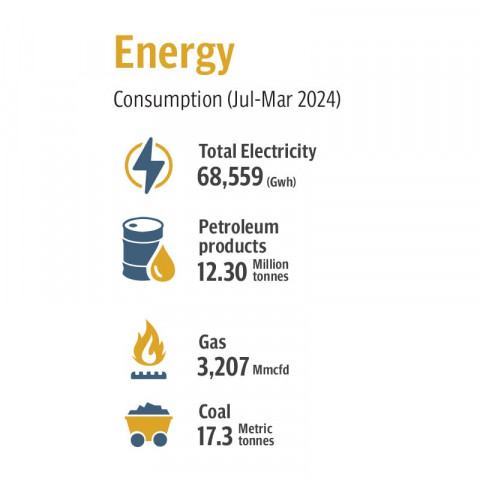IPPs get Rs2.8 billion windfall every year
Consumers forced to pay heavy charges to these independent plants due to flawed policies

The present government has continued to follow the flawed policies of previous administrations under which independent power producers (IPPs) get a windfall of over Rs2.8 billion in capacity payments from electricity consumers every year.
As of the end of March 2024, Pakistan’s total installed power generation capacity stood at 42,131 megawatts. It is not even using half of the capacity but the honest consumers, who pay bills regularly, are forced to pay 70% of the total amount in capacity charges to those power plants that do not generate even a single unit of electricity.
The government made the shocking disclosure in the Pakistan Economic Survey 2023-24 released on Tuesday.
According to the report, the Private Power and Infrastructure Board (PPIB) has managed to get developed 100 IPPs with a combined production capacity of about 24,958 megawatts, more than half of the country’s total capacity, by attracting foreign direct investment of $33 billion.
In addition, five multiple fuel-based IPPs of 1,066MW are at advanced stages of construction and expected to be completed during 2024-25. This signals that the government is continuing to set up power plants, which will result in more capacity payments.
The economic survey is silent about hydroelectric power projects. However, it revealed a plan for future solar energy projects, though the government was moving away from net metering, considered the best solution for minimising power outages and reducing consumer bills.
The upcoming power generation projects, being processed by the PPIB, comprise 24 projects of 7,460MW, which are at different stages of completion. Under the Integrated Generation Capacity Expansion Plan (IGCEP) 2022 and current policies, the PPIB aims to complete 12 IPPs’ projects of 1,563MW between 2024 and 2026.
Out of Pakistan’s total installed capacity of 42,131MW, the share of hydel, nuclear, renewable and thermal energy is 25.4%, 8.4%, 6.8% and 59.4%, respectively. The share of thermal power, as a dominant source of electricity supply, has declined over the past few years, indicating increased reliance on indigenous sources.
In the total electricity generation of 92,091 gigawatt-hours (GWh), the share of hydel, nuclear and renewable energy stands at 54.1%. It “can be seen as a positive sign for the economy as the sources of electricity generation shift from thermal to cleaner sources”, said the Economic Survey.
During (July-March) FY24, total electricity consumption was reported at 68,559 GWh, where the household sector was the largest consumer at 33,737 GWh (49.2%). It was followed by the industrial sector with consumption of 18,022 GWh (26.3%) while agriculture and commercial sectors utilised 6,905 GWh (10.1%) and 5,365 GWh (7.8%), respectively.
Electricity consumption by other sectors (streetlights, general services, and other government) came in at 4,530 GWh, or 6.6%.
In Pakistan, the transport sector is the major consumer of petroleum products, accounting for 79% of total demand. However, during the current fiscal year, the consumption of motor spirit (petrol) and high-speed diesel (HSD) decreased mainly due to their high prices.
As a result, total consumption of petroleum products contracted 7.2% during July-March FY24 compared to the same period of last year.
The government attributed the decline in oil consumption to exorbitant prices, but it did not talk much about the flood of smuggled oil from Iran. This illegal trade has increased during the rule of the current government.
The legitimate oil industry has time and again raised hue and cry about the unchecked smuggling, but to no avail. Oil demand dropped to 12.3 million tonnes during July-March FY24, from 13.3 million tonnes in the same period of last year.
The declining trend may be attributed to a decrease in demand for HSD, motor spirit and furnace oil, which consist of more than 95% of total consumption. Total demand for petroleum products had been at 17.5 million tonnes during FY23.
Transport and power sectors were the major oil consumers, representing 77.3% and 10.7% of total demand, respectively. Overall, total demand for petroleum products dipped 7.23% during July-March FY24.
Being a net importer of petroleum products and crude oil, Pakistan imported around 11 million tonnes valuing at $8.4 billion during July-March FY24.
Major imported petroleum products were motor spirit, HSD and crude oil with volumes of 3.53 million tonnes, 1.23 million tonnes and 6.17 million tonnes, respectively.
During the period under review, because of government’s efforts, Pakistan’s reliance on furnace oil for power generation declined, leading to zero imports compared to purchases valuing at $307.7 million in FY23.
During July-March FY24, total gas consumption of the country was estimated at 3,207 million cubic feet per day (mmcfd), which comprised natural gas consumption of 2,512 mmcfd and re-gasified liquefied natural gas (RLNG) demand for 695 mmcfd.
Natural gas is a clean, safe, efficient and environmentally friendly fuel. Its indigenous supply contributes about 28.9% (FY23) to the total primary energy mix.



















COMMENTS
Comments are moderated and generally will be posted if they are on-topic and not abusive.
For more information, please see our Comments FAQ